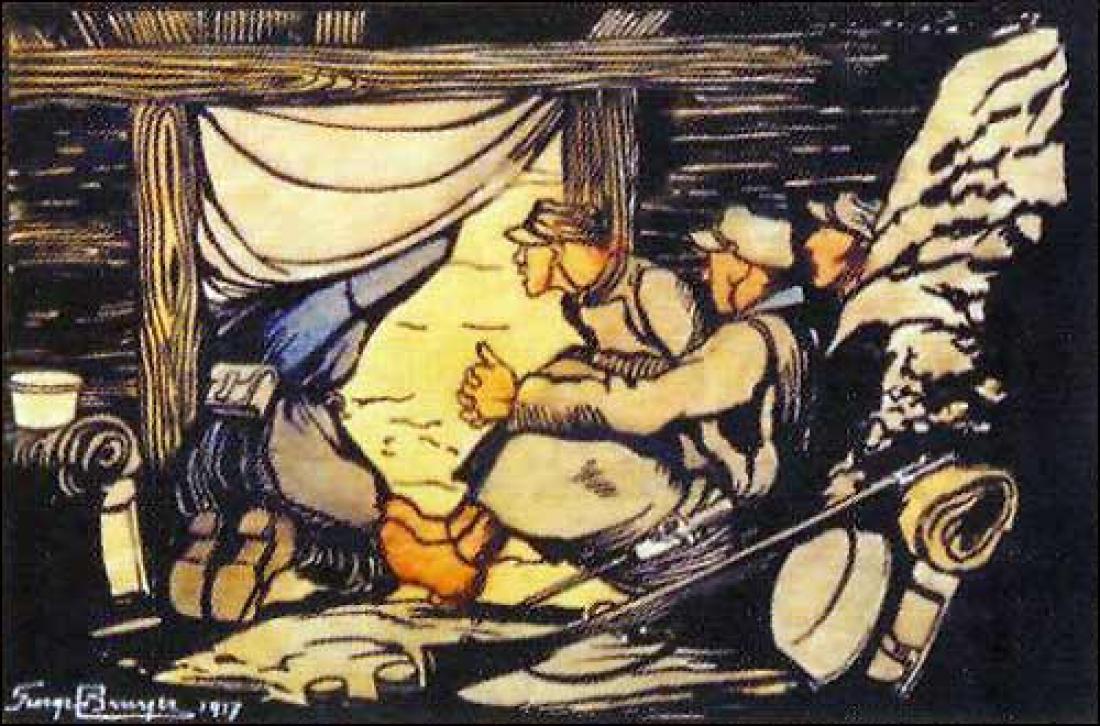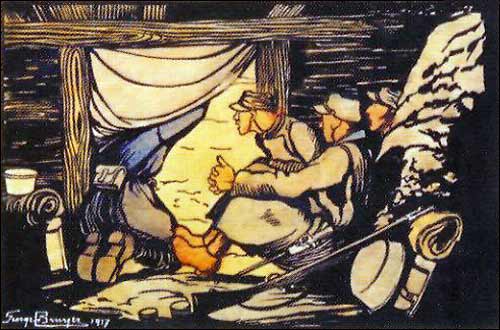La peinture et la Grande Guerre

Corps 1
The collections of the Historial de la Grande Guerre The Great War was a human tragedy. Millions from every continent died. Millions of others were mutilated and went home with wounded hearts and minds, if they managed to survive at all. It was a geo-strategic earthquake that caused Europe to implode and redrew borders. People thought the First World War would be the last yet it was one of the causes of the Second. How could art have stayed out of so much violence and upheaval? And yet, there was a sort of "absence".
Corps 2
In 1914 artists, like all their fellow citizens, were called up, sent to the front and faced with the horrors of total, modern and mechanical warfare. The conflict spawned many works, but few reflect the new weapons' destructive power, the ferocity of the fighting or the cruelty of hand-to-hand combat. True, illustrators posted at the front had little time to sketch their impressions in a pad. They were in the mud, under fire, in a climate of death and fear from which they wanted to escape. In addition, censors kept an eye on soldier-artists' drawings and the military authorities supervised their exhibitions. Above all, newspaper photography became the main medium to illustrate the carnage and the violence of life under fire.
Portraits of soldiers, landscapes of ruins, daily life, etc.
The mostly "classic" style of works from the Great War translates a certain reality in a descriptive and aesthetic way. Painters on mission for the army, such as Vuillard, Gillot, Colin, Dauphin and Steinlen, gave a traditional view of the war in the same vein as in 1870, glorifying the army's power and the troops' high morale. They are represented in the collections of the Historial de la Grande Guerre in Péronne. Whether they were German, French or British, artists also emphasized portraits of soldiers-on their side or the enemy's-landscapes of ruins and everyday scenes from military life. Watercolours by artist-combatants feature a certain pedagogical dimension, seeking to record ordinary life as well as extraordinary events as they personally experienced them. The watercolours the Historial has acquired reflect a desire to record reality with an aesthetic, easy to understand style. The series on display is representative of the entire "fine arts" collection and offers a predominantly French viewpoint, with a balance of prints and drawings, which were easier to make in a sketchbook. Both often lack dates. Not all were made from life and it is sometimes hard to determine whether the men who did them were in uniform. Foreign artists at the Historial are more represented by oils on canvas. Examples include On Patrol (Jank Uhlan), French Soldiers (Arthur Kampf) and Christ Appearing to Soldiers of All Nationalities (Will Longstaff). Front-line artists were "special" eyewitnesses who, like their comrades-in-arms, lived in danger, fear and suffering, but few works reflect the violence of the fighting. Most show ruins, streams of prisoners and scenes from everyday life; few depict death, especially that of their fellow countrymen. The work of Jean Droit, which certainly has a pedagogical dimension-La route est repérée (The Road Has Been Located, 1914) and Un 210 éclate (A 210 Explodes)-is similar to Pierre-Albert Leroux's Corvée de soupe (Soup Duty). Mathurin Méheu painted a very colourful picture of Clemenceau visiting the trenches: the style is rather unusual because the overall trend was towards a classic realism creating distance between the viewer and the battlefield. Works by Army Museum painters (Berne-Bellecour and Desvarreux, who are represented at the Historial) as well as by artists on army missions (Vuillard, Devambez, Renouard, Colin, Gillot and Balande, also on display at the Historial) reflect everyday military life, far from fighting under fire. Some let more emotion show through: Maurice Le Poitevin conveys many aspects of his own experience, and Zinoviev, a Russian soldier in the Foreign Legion, depicts the soldier's hardships as well as his fantasies.
Bolstering French morale and demonising the enemy
In the climate of intense Germanophobia and extreme violence, propaganda images played a major role throughout the conflict. Total war resulted in civilian victims: French artists demonised the enemy. For example, in a series of prints, Les quatre saisons de la Kultur (The Four Seasons of Kultur), Hermann-Paul focused on German atrocities. Bénito's Crucifié (Crucified), Tribout's À qui le 2ème ? (Who Will the 2nd One Get?) and Joanny Durand's Prière (Prayer) deal with the same theme by emphasizing mutilations. Many cartoons were produced during the war. Caricatures by Poulbot and Forain take a humorous but often dark approach to the war through the eyes of civilians, who also had to "hold on". The posters at the Historial de la Grande Guerre (approximately 2,000, many of which are on display) demonstrate to what extent art's goal was keep the population's spirits and hopes in victory high. The style is often simple but expressive and easy to memorise. The war led some artists to develop an innovative style. A case in point is André Mare, who was assigned to the camouflage section. The Historial has his Soldat nègre mort, Biaches, 1916 (Dead Negro Soldier, Biaches, 1916), made from his sketchbook. Mare stylised the silhouette and simplified features under the influence of Cubism, a style he did not really develop until the years between 1915 and 1918. As though trying to ward off his own death, in ten wartime sketchbooks he drew just two dead soldiers.
The "silence of the painters"?
Is the impossibility of painting absurd barbarism one of the reasons for the "silence of the painters" Philippe Dagen talked about when he said his phrase "does not presuppose that there is no depiction of the war, but asks why there are so few paintings whose artistic quality earn them a place in the history of modern art"? True, photography was booming and the press was hungry for spectacular pictures from the front, ushering in, as Dagen said, "the epoch of live death". The heroic era of cavalry charges and colourful battles had given way to that of soldiers buried in mud or trenches and bodies torn to bits by shrapnel. The Dada movement (1916), British Vorticism, German Expressionism, Futurism and Cubism marked the avant-garde. Avant-garde works at Historial include a print by Christopher Nevinson, A Dawn, 1914, showing the influence of Futurism, and an ink drawing by Fernand Léger, Infirmerie à Villepinte (Infirmary in Villepinte, 1917), which structures the space with basic geometric forms where the illusion of depth and relief are totally absent. Léger was the only artist who really used Cubism in his wartime works. Assigned to the artillery, he said "nothing could be more Cubist than the Great War, which cuts you up into bits and scatters you to the four cardinal points". The Germans used the latest trends in the visual arts better than the French and ushered in the fierce style of the 1920s with Expressionism, which Otto Dix used with exceptional intensity to translate his nightmarish visions of the war. Dix volunteered in 1914 and made all kinds of sketches when he was a soldier, but did not paint his big war pictures until after 1918. His 1924 series of 50 etchings Der Krieg (The War) is an almost unbearable personal testimonial. He is the only artist who seems to have overcome the challenge-but not until after the war-of depicting "the devil's work" by breaking the taboo of the incommunicability of the battlefield's horrors, the corpses, the shelling, etc. The series, which is on display at the Historial, recalls how decisive his wartime experience, which, he said, "was enough to make you lose your taste for art", was for his work. It features a wide variety of artistic styles, but Expressionism dominates to express the war's "brutalisation". On the whole, artists used abstraction very little during this period to deal with the war's modernity. Only Pierre Albert-Birot, a 30-year-old non-combatant, dared to produce an abstract painting, in 1916, entitled La Guerre (The War).
Freed from the fetters of tradition, postwar Europe witnessed the blossoming of a major art renaissance. It was hard for artists who had fought in 1914-18 to confront taboos and freely express the violence they had endured, but the first-hand accounts about their experiences are indispensable for understanding the First World War. Although Paul Klee remarked "the more terrifying the world is, the more abstract art becomes", the Great War is not what led soldier-artists to adopt that style. Nevertheless, the art of the period shows that the Great War was a turning point between the 19th and 20th centuries, tradition and modernity. Most work by artists who fought shows an attachment to realism in depicting the tragedy they lived through. Few adopted an innovative style that could depict modern warfare.
The Historial de la Grande Guerre in Péronne

Georges Bruyer "Combat d'artillerie", 1917. Photo DMPA

